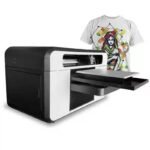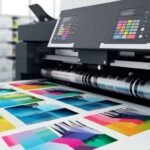Introduction to DTF Printing Technology
Direct-to-Film (DTF) printing technology has emerged as a significant innovation within the custom apparel and textile industry. This process involves transferring ink onto a specially coated film, which is then applied to fabrics using heat and pressure. DTF vs UV DTF Printer Differences are important to understand, as DTF printers utilize high-quality inks, typically water-based, which ensure vibrant colors and exceptional durability. The purpose of DTF printing is to provide a versatile and efficient method for decorating garments, textiles, and other materials, catering to both small-scale businesses and large manufacturing operations.
The primary advantage of DTF printing lies in its ability to produce detailed designs with a wide range of colors. Unlike traditional methods, such as screen printing, DTF allows for intricate patterns and images to be printed directly onto the film, enhancing flexibility in design choices. Additionally, DTF printing is suitable for a variety of fabric types, including cotton, polyester, and blends, making it an attractive option for various applications—from promotional merchandise to personalized clothing.
One of the key components of DTF technology is the use of adhesive powder, which is applied to the printed film. This adhesive, once melted during the heat transfer process, bonds the ink to the fabric, ensuring longevity and resistance to washing. Moreover, the technology reduces the need for pre-treatment of fabrics, streamlining the production process and minimizing costs for businesses. Furthermore, DTF printers operate with minimal waste, making them an eco-friendly choice compared to other printing methodologies.
In conclusion, DTF printing technology plays a vital role in revolutionizing the way custom apparel is produced. Its benefits, ranging from versatility and efficiency to high-quality output, render it a valuable asset in the textile industry, catering to the demands of consumers and businesses alike.
Exploring UV DTF Printing: What Sets it Apart
UV Direct-to-Film (DTF) printing is an innovative technology that distinguishes itself from traditional DTF methods through its unique use of ultraviolet light for curing prints. This process involves applying specially formulated UV inks to a transfer film, which is then exposed to ultraviolet light, causing the ink to solidify almost instantly. This rapid curing not only enhances the durability of the prints but also allows for vibrant colors and intricate details that can be achieved on a variety of surfaces.
One of the critical materials utilized in UV DTF printing is the eco-friendly film that acts as a carrier for the ink. Unlike conventional DTF techniques, which often require a heat press, UV DTF prints can adhere to a wide range of substrates, including plastics, glass, wood, and metals. This versatility makes UV DTF printing a preferable choice for many industries, where the ability to print on unconventional materials can significantly expand creative possibilities.
The benefits of UV DTF printing are manifold. Firstly, the immediate curing process reduces the time needed for production, allowing for quicker turnaround times. Furthermore, the prints produced are resistant to fading, scratching, and other forms of wear, making them ideal for applications requiring longevity, such as promotional items, signage, and custom merchandise. Additionally, UV DTF printers can produce striking designs that stand out visually, thus catering to markets where aesthetics are paramount.
When it comes to applications, UV DTF printers excel in various projects, from personalized gifts to large-scale commercial signage. Their ability to work on different surfaces expands potential markets, allowing businesses to tap into diverse customer demands. As a result, UV DTF printing not only enhances quality and efficiency but also offers creative freedom that many traditional methods may not provide.
Key Differences Between DTF and UV DTF Printers
Direct-to-Film (DTF) and UV Direct-to-Film (UV DTF) printers represent distinct technologies that cater to varying printing needs. The primary difference lies in the printing technology itself. DTF printing utilizes a combination of specially coated films and heat transfer methods to apply designs onto various substrates, mainly textiles. In contrast, UV DTF printing employs ultraviolet light to cure the ink as it is printed, making it more suitable for hard surfaces such as plastics and metals.
Versatility is another critical factor to consider when comparing these two technologies. DTF printers are predominantly used for printing on fabric and soft materials, making them ideal for apparel businesses. They excel in flexibility, enabling users to print vibrant designs on various textiles. Conversely, UV DTF printers can print on a broader range of surfaces, including hard substrates, which allows for greater application diversity, such as promotional items, signage, and industrial labels.
When it comes to color vibrancy, DTF printers are known for their ability to produce vivid colors and intricate designs on fabrics. The DTF technique employs a specialized ink that maintains its brightness even after multiple washes. On the other hand, UV DTF printers deliver exceptional color quality and fine detail on solid surfaces, often producing a glossy finish that enhances the visual appeal of the printed materials.
Durability is another crucial distinguishing factor. DTF prints are resistant to fading and cracking on textiles but require proper heat settings for optimal results. Conversely, UV DTF prints are highly durable, providing resistance against scratching and environmental factors, making them ideal for long-lasting applications.
Finally, the cost of acquisition and operation can vary significantly between the two options. DTF printers are generally more affordable upfront, while UV DTF printers may represent a higher initial investment due to their advanced technology. Understanding these differences can help businesses make an informed decision based on their specific needs and budget.
Choosing the Right Printer for Your Business Needs
When selecting between a traditional DTF printer and a UV DTF printer, several key factors come into play that can significantly influence the choice based on specific business needs. Understanding these factors will ensure that you invest wisely in a printing solution that aligns with your operational requirements.
First and foremost, budget is a crucial consideration. Traditional DTF printers generally have a lower initial investment compared to UV DTF printers, which tend to be more expensive due to their advanced technology and capabilities. However, it’s important to factor in the costs associated with materials, maintenance, and potential longevity of the printer, as these aspects can affect your overall expenses in the long run.
Next, consider the desired applications of the printing process. Traditional DTF printers are well-suited for fabric prints, making them ideal for garment manufacturers and custom apparel businesses. Conversely, UV DTF printers offer versatility, enabling you to print on a wider variety of substrates such as plastics, metals, glass, and wood. Therefore, evaluate the types of products you plan to print to determine which printer aligns better with your business’s core services.
Production volume is another factor to contemplate. If your business demands high volume output consistently, a UV DTF printer may be more efficient due to its faster production capabilities. However, for smaller, niche operations that focus on custom designs, a traditional DTF printer may suffice.
Quality requirements also play a significant role in your decision-making process. Traditional DTF printers deliver excellent color vibrancy, particularly useful for detailed fabric designs. UV DTF printers, on the other hand, ensure enhanced durability and scratch resistance, making them a strong choice for items that will undergo frequent handling.
Lastly, staying informed about trends in printing technology can aid in making an enlightened choice. As advancements continue to evolve, consider factors such as sustainability and environmental impact, as these considerations may soon become more important in shaping consumer preferences.
Read More: Why You Should Buy a DTF Printer?



